Topic of ERICA
Worldclass Researchers
Ranked among the Top 2%
at ERICA
TOP 2%
Global Researcher
When we talk about the research strength of a university, the usual indicators used include the size of the university in terms of population, whether it has a medical college, or if it has prominent researchers. Among these measures, the category of renowned researchers takes the lion’s share due to their research impact and influence. Among the world’s most prominent researchers ranked among the top 2%, are professors at Hanyang ERICA. Due to their valuable research achievements, they are serving as growth engines of the campus. Needless to say, ERICA is gaining more global attention as a research-oriented university.
- Compiled by · the Editorial Office

Worldclass Researchers Ranked among the Top 2% at ERICA helping to Boost its Competitiveness in the Research Field
Elsevier is a global information analytics company that publishes research of the world’s top 2% scholars. The list was analyzed by Professor John P.A. Ioannidis at Stanford University in the U.S. who found the number of the world’s top 2% of researchers represents the number of those with world-class research competitiveness and in turn, are representing their university. As of November 2022, Korea ranked 17th with 1,881 researchers who were named in the list.
Hanyang University has 89 scientists listed in the world’s top 2% of researchers, ranking HYU 6th among Korean universities. In particular, 21 researchers of the 393 full-time faculty members (5% of the total of faculty members) at ERICA were included in the list. Compared with Chung-Ang University (25 researchers or 3% of its 969 full-time faculty members), and Ewha Womans University (23 researchers or 2% of its 989 full-time faculty members), ERICA has more than twice the number of its counterparts, which highlights ERICA’s research competitiveness.
Best South Korean Universities named in the Top-2% Citation List
(Released by Elsevier Korea in November 2022)
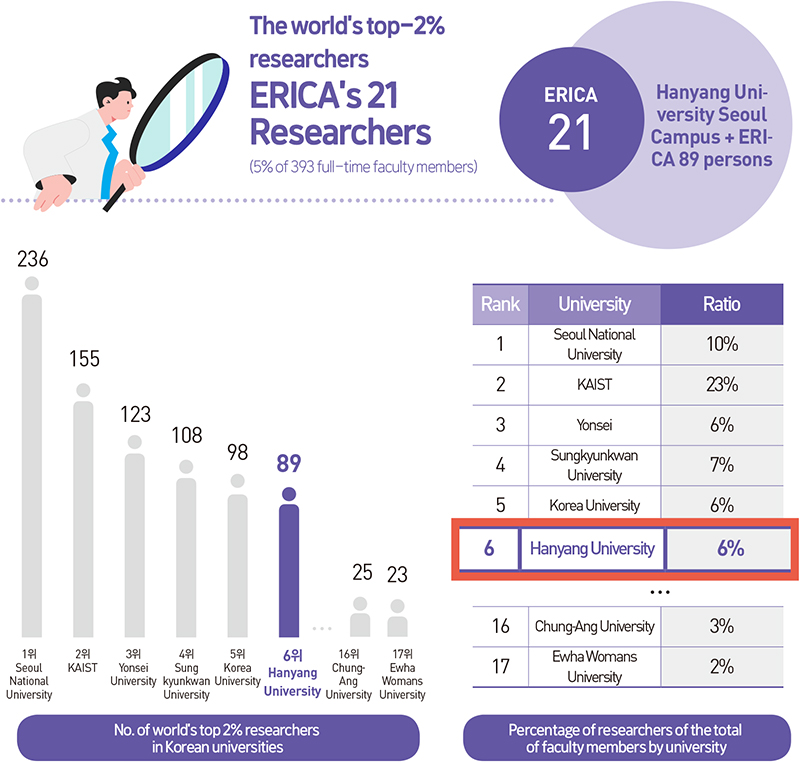
ERICA, a Powerhouse in the Science and Engineering Fields
The size of the research grant received by a university is a factor that enables the development of research infrastructure, quality improvement, and nurturing of researchers. It can also be seen as an important indicator for assessing the research potential and competitiveness of a university. If calculating the share of off-campus research grants secured by each college in 2021, the science and engineering fields showed the largest portion at ERICA. Moreover, the result of counting current off-campus research grants of science and engineering colleges of major domestic universities (based on data disclosed for the years 2019-2021) revealed that ERICA ranked 7th among the top 20 domestic universities in terms of research grant per faculty member. Furthermore, ERICA ranked 2nd among the top five universities that do not have a school of medicine, showing the increasing competitiveness of ERICA science and engineering researchers.
ERICA ranks the highest among universities even when compared with institute of science and technology or “IST” universities, which do not have a school of medicine and consist only of science and engineering professors. As many as 20 professors (8.5%) out of the 233 full-time science and engineering professors at ERICA were named in the world’s top 2% researchers list, demonstrating that ERICA is home to outstanding researchers active in the science and engineering fields. By comparison, UNIST had 33 of 324 faculty members listed, or 10%, while GIST had 21 of 156 faculty members, or 13.4%.
Current Status of Research Grants Secured by Science and Engineering Faculties of Domestic Universities without a School of Medicine
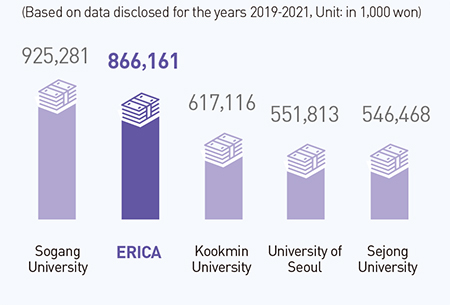
Ratio of the world’s top 2% researchers at ERICA’s science and engineering field and IST universities in Korea
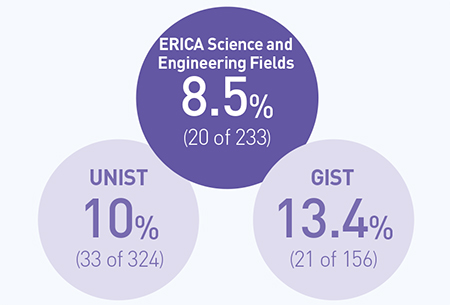
Strategies to nurture and strengthen the impact of top- 2% researchers
The researchers in the world’s top 2% list have the potential to be elevated to the top 1%. Thus, it is very important for universities to come up with measures to support and encourage these researchers. Increased demand for exchanges among researchers in related fields and interdisciplinary convergence has inspired Hanyang University to conduct innovative research in addition to its existing strengths.
Group research to create synergy that enhances Hanyang University’s strengths
Five research institutes of Hanyang have created an environment that seeks to optimize group research. These institutes focus on conducting converged research with participating professors from various departments based on the area of each research institute. The five research institutes are seeking to improve their citation index, industry- academia collaboration and technology transfer, and technology-based startups through group clinical research on energy, semiconductors, and the bio sector. As each research institute at Hanyang University cooperates with each other to discuss the establishment of a consortium to win research projects, such efforts are expected to maximize the competitive edge of the university. The bio and pharmaceutical fields in particular, which are representa-tive fields for group and converged research, have shown a relatively high field weighted citation impact (FWCI) and citation index per paper. Thus, there are expectationsfor high-quality research results through the Hanyang Institute for Precision Therapeutics and Hanyang Institute of Environmental and Energy Technology, established at ERICA in 2022.
In addition, according to an analysis of the current ERICA’s science and engineering research results, the quality index (Q1 ratio, citations per paper, FWCI) of international joint research papers is higher than that of local joint research papers. If institutional support is provided to promote international joint research through a specialized research institute consisting of ERICA’s prominent researchers, there is a high possibility that more world-class FWCI papers would be published.
Analysis of ERICA’s joint research over the past four years
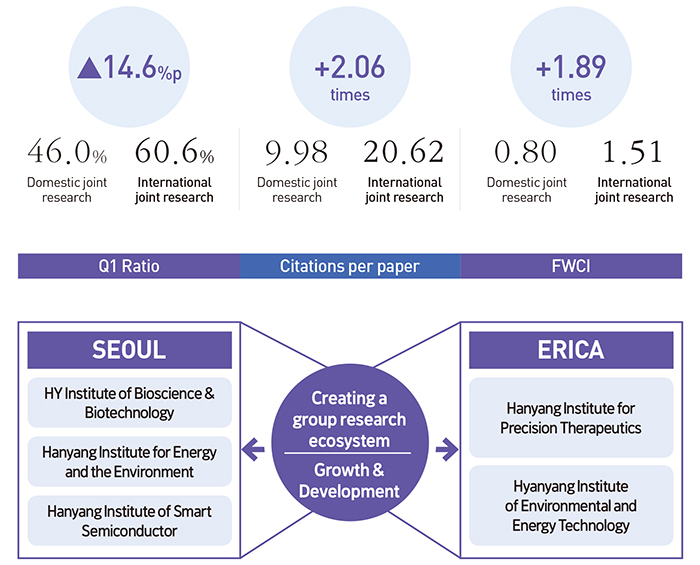
Advancing to become a research-oriented university and a leader in industry-academia collaboration
Since world-class researchers contribute to improving the research competitiveness of a university, it is imperative that Hanyang establish policies to incentivize and programs to motivate its researchers. Institutional support is necessary for researchers to sustain their research capabilities. Support for international joint research must be supported and venues for exchanges should be provided, centering on research fields with high performance, while unlocking the more potential at Hanyang by tapping into the growth potential of researchers on campus. ERICA has sufficient strengths and potential in the field of bio-health and new medicine development based on converged research through cooperation among Hanyang Institute for Precision Therapeutics and science and engineering fields, where renowned researchers can be found. Furthermore, there are great possibilities involving the use of the research infrastructure at ERICA through the Campus Innovation Park which could bring about various synergies.
The world’s top 2% researchers who are greatly contributing to Hanyang and the global community
The following are some insights from two highly ranked professors who share their background, research vision, and views on promoting social innovation and future university development.
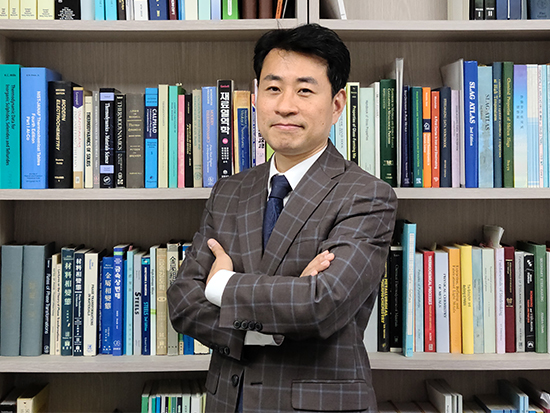
Joohyun Park Professor of Materials Science and Chemical Engineering
Major career and competencies
- 2020 - Present : Visiting Professor, Beijing University of Science and Technology
- 2021 - Present : Scholarly Professor at a research lab Designated by Hyundai Steel (Hyundai Steel)
- 2022 - Present: Member of the Carbon Neutral Green Steel Technology Advisory Committee (POSCO)
- 2021 Key Reader Award, Metallurgical and Materials Transactions, TMS, USA
- 2021 Winner of the Trade, Industry and Energy Ministerial Award (Korean government)
- 2021 Recipient of the Chung Woong Award from the Korean Institute of Metals and Materials Society
- 200 Peer-reviewed SCI papers, 220 International Conference Presentations (40 Plenary/Keynote Lectures)
You are contributing to the development of new technologies through your research and were involved with the selection of the first research lab designated by Hyundai Steel in 2021. Please introduce your research area and share your future vision and values.
Did you know the fact that Korea is the world’s No. 1 steel consumer? Korea is the sixth largest steel producer, consuming about one ton of steel per person per year. I have been conducting basic research to help manufacturers create the best quality steel products for over 20 years. I have a vision of providing a beautiful and peaceful Earth for future generations to inherit. My research lab will develop eco-friendly steel manufacturing technology to make this dream a reality.
You have been constantly named in the world’s top 2% researchers list. This is no small feat. What has made this possible?
My achievements are based on those of the masters and doctoral students who research together at the lab. We discuss research from time to time, logically refine the discussion results, and release our published papers to share with the public. The motto of our lab is “Unus pro omnibus, omnes pro uno” meaning One for all, All for one. My firm belief is that the efforts of every researcher makes results in the best achievements.
Please describe your future research plans and in what areas you think researchers and the university should cooperate.
Korea joined the declaration of Carbon Neutral 2050, following Europe. We cannot live without iron, but its production emits large amounts of carbon dioxide. So researchers around the world are aiming at developing steel manufacturing technology that minimizes carbon emissions by 2050. This is also my goal and plan. To achieve this, academia, industries, and governments must conduct systematic and continuous research, while universities must nurture talented people.

Jin Ho Bang of the Department of Chemical and Molecular Engineering
Major career and competencies
- 2020 - Present : Expert at the Center for Natural Sciences, National Research Foundation of Korea
- 2022 - Present : Editor of ACS Energy Letters
- Published 106 papers, registered 30 patents
- h-index : 36, > 7,168 citations (based on Google scholar)
- Awarded the 1st Gyeonggi-do Science and Technology Award (2021) and many other awards for excellence in research achievements
- Founded ”GH2 Energy”, a technology company specializing in water electrolysis 9December 2022)
Your high-quality research are featured in top 1% thesis journals, which is very impressive. Please introduce your research field and vision for the future.
My research field includes the development of electrode materials for energy conversion and storage systems such as lithium secondary batteries, water electrolysis for green hydrogen production, and solar cells, as well as analysis of various interfacial reactions occurring in electrodes. Based on academic expertise in the fields of solid chemistry and electrochemistry, I conduct research that provides new insights into the development of new electrode materials and the characteristics of electrode materials. Taking into consideration the impact of energy issues, such as the depletion of fossil fuels and environmental pollution, I have been engaged in research to join global efforts to find answers to these challenging issues.
What has enabled you to achieve research influence as a world’s top 2% researcher?
I have constantly raised questions about unresolved issues in my field of research and always seek creative research directions. I think doing so is my main strengths. And I believe that enthusiasm of researchers who work together, and the diversity gained through collaboration with global researchers in various research fields has an important factor increasing the impact of my research achievements.
What do you think are the most important factor for the mutual growth of the university and its researchers, and what do you perceive are ERICA’s strengths?
I don’t think that it’s possible to create a research ecosystem for researchers unless the human and material infrastructure is properly established within a university. ERICA has been committed to recruiting excellent students, research equipment, and administrative support so that researchers can work without any difficulties. In addition, I want to point out various industry- academia cooperation channels that ERICA has established to disseminate its research results to industries rather than just confining them to academic achievements is one of ERICA’s strengths.





